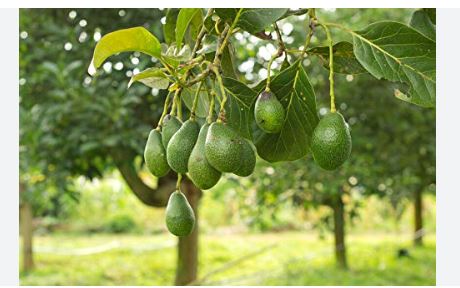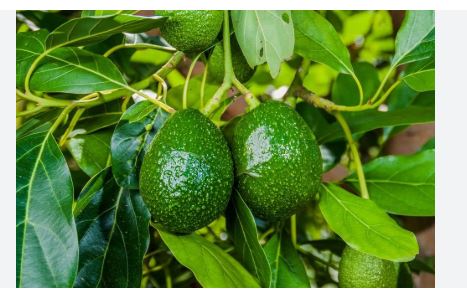
The Gwen avocado is a cultivar of Persea americana, a species within the Lauraceae family, which also includes laurel, cinnamon, and bay trees. Botanically, it’s classified as a berry, characterized by its single large seed surrounded by fleshy pulp, though it’s typically used as a vegetable in culinary contexts. Gwen is a hybrid with predominantly Guatemalan ancestry (about 80-90%), crossed with a minor Mexican influence, likely from its parentage involving Hass and Thille varieties. This Guatemalan dominance gives it a rich, oily flesh and thicker skin, while the Mexican trace adds a slight boost in cold tolerance, distinguishing it from purebred varieties like Fuerte or Bacon.
Originating in California, the Gwen avocado emerged from the University of California’s breeding program under horticulturist Robert Bergh. In 1956, Bergh crossed a Hass avocado with a Thille seedling at the Citrus Experiment Station in Riverside, aiming to create a high-yielding, dwarf variety. Patented in 1984, Gwen was heralded for its productivity and compact size, promising double the fruit per acre compared to Hass. Despite early optimism, its commercial run faded by the 1990s, overshadowed by Hass’s market dominance and Gwen’s specific growing challenges, though it retains a cult following among backyard growers and avocado enthusiasts.
Identifying a Gwen avocado is easy once you know its hallmarks. It’s oval to slightly rounded, a bit larger than Hass, weighing 6 to 15 ounces (170-425 grams). Its skin is thick, pebbly, and remains a dull green even when ripe—unlike Hass, which turns purplish-black. The flesh is creamy, gold-green, with a high oil content (around 18-22%), encasing a small to medium seed that maximizes edible yield. Its texture is buttery and dense, often described as smoother and richer than its Hass parent, making it a visual and tactile standout.
Gwen avocados are suited to USDA Hardiness Zones 9 to 11, thriving in warm, subtropical climates with minimal frost. They’re less cold-hardy than Mexican varieties, tolerating down to 30°F (-1°C) briefly, but prolonged cold or heat stresses them significantly. Coastal California—think Riverside or San Diego Counties—offers the best conditions, with well-drained soils and protection from wind and drought. Gwen’s sensitivity to environmental extremes, compared to hardier cultivars, partly explains its retreat from large-scale cultivation.

Seasonality for Gwen runs from late winter to fall, typically February to October in California, with peak availability in spring and summer. It’s harvested mature but unripe, ripening off-tree, and its thick skin allows some on-tree storage, though not as flexibly as Hass. Once a commercial hopeful, Gwen’s availability has shrunk to niche markets, local nurseries, and home gardens, overshadowed by Hass’s year-round presence via imports. Its long season remains a draw for those who can source it during these months.
Culinary uses of Gwen avocados highlight its nutty, buttery flavor and luxurious texture. It shines in guacamole, where its richness pairs with lime and spices, holding its own in chunkier mixes. Sliced or diced, it elevates salads, sandwiches, or wraps, complementing fresh ingredients without dominating them. Its creamy flesh blends seamlessly into smoothies or spreads for toast, offering a subtle sweetness that some prefer over Hass. Raw is best—cooking risks bitterness—but Gwen also stars in cold soups or desserts like avocado mousse in adventurous kitchens. Its superior taste and yield make it a hidden gem for those lucky enough to find it.
Cultivation of Gwen Avocado
Climate Requirements
Gwen avocados thrive in USDA Hardiness Zones 9 to 11, preferring warm, subtropical climates with temperatures between 65°F and 85°F (18°C to 29°C). Their Guatemalan dominance limits cold tolerance to brief dips around 30°F (-1°C), with frost damaging blossoms and young trees. Growers in California’s coastal zones use sprinklers or frost blankets during rare cold snaps to safeguard crops.
Soil Preferences
Excellent drainage is essential, as Gwen is prone to root rot (Phytophthora cinnamomi). Sandy loam or loamy soils with a pH of 6.0 to 6.5 promote aeration and water flow, ideal for its shallow roots. Heavy clay requires raised beds or organic amendments (e.g., compost) to prevent saturation. Soil testing ensures proper drainage and nutrient levels before planting.
Site Selection
Flat or slightly sloped land (up to 10% grade) suits Gwen, aiding drainage while supporting its dwarf stature. Full sun—6-8 hours daily—is critical for fruit production, and wind protection (natural ridges or planted screens) guards its dense fruit load from damage. Coastal California sites, shielded from extreme heat or wind, match Gwen’s need for stability.
Tree Propagation
Gwen is propagated by grafting onto vigorous rootstocks like ‘Toro Canyon’ or ‘Duke 7’ to ensure disease resistance and maintain its dwarf, productive traits. Seeds won’t produce true Gwen fruit due to its hybrid origins, so nursery grafts—scions from certified trees—are grown for 12-18 months before transplanting. This preserves its compact size and rich flesh.
Planting
Trees are spaced 10-15 feet (3-4.5 meters) apart, tighter than most varieties due to Gwen’s dwarf nature, though pruning adjusts for density. Spring planting, post-frost, is optimal in regions like California, allowing roots to establish before summer heat. Holes twice the root ball’s size are enriched with compost, and stakes support young trees against wind until rooted.
Irrigation
Gwen requires moderate, precise watering—15-35 gallons (55-130 liters) per tree weekly, adjusted for rainfall and soil type. Drip irrigation targets the root zone, avoiding overwatering that its Guatemalan roots despise. Young trees need 2-3 weekly sessions, tapering as they mature. Soil moisture sensors balance hydration with drainage, preventing rot.
Fertilization
Nitrogen is applied at 1-1.5 pounds (0.45-0.7 kg) per tree yearly, split into spring and midsummer doses to fuel its high yield. Zinc and boron supplements address deficiencies, often via foliar sprays in sandy soils. Organic mulch or balanced fertilizers (e.g., 10-10-10 NPK) sustain health, but over-fertilizing risks vigor over fruit, so leaf analysis refines applications.
Pollination
Gwen is a Type A flowerer—female in the morning, male the next afternoon—self-fertile but benefiting from cross-pollination. Pairing with Type B varieties like ‘Bacon’ or ‘Zutano’ boosts fruit set, as bees bridge bloom overlaps (February-May in California). Orchards often add hives to maximize pollination, leveraging Gwen’s dense fruiting potential.
Pruning
Moderate pruning shapes Gwen’s compact canopy, removing dead wood or crowded branches to enhance light and airflow. Young trees are trained into a rounded form over 2-3 years, while mature trees get annual thinning post-harvest (fall) to manage fruit load. Its dwarf size reduces heavy pruning needs, but careful cuts maintain productivity.
Pest and Disease Management
Persea mites and thrips are key pests, controlled with predatory insects (e.g., lacewings) or targeted sprays like sulfur. Root rot is the main disease, countered with resistant rootstocks and strict irrigation control. Regular scouting and debris removal limit pest spread, favoring integrated pest management over broad chemicals.
Fruit Development
After pollination, Gwen fruit matures over 10-12 months, ready for harvest from February to October in California. It ripens off-tree, with dry matter content (22% minimum) signaling maturity. Fruit weighs 6-15 ounces (170-425 grams), with size tied to water, nutrients, and thinning—its heavy yield may require branch support.
Harvesting
Gwen is picked mature but firm, with clippers snipping stems to preserve thick skin. Timing aligns with oil content tests, peaking in spring to summer for market demand. Workers use ladders for its shorter stature, collecting into padded bins to avoid bruising its dense fruit, a plus over thinner-skinned types.
Post-Harvest Care
Harvested fruit is cooled to 40-50°F (4-10°C) to slow ripening, then graded for size and quality. Ripening occurs off-tree at 65-75°F (18-24°C) over 7-14 days, or hastened with ethylene commercially. Thick skin offers decent shelf life, though less than Hass, so timely handling is key. Mature trees yield 120-200 pounds (54-90 kg) annually, reflecting its breeding for abundance.